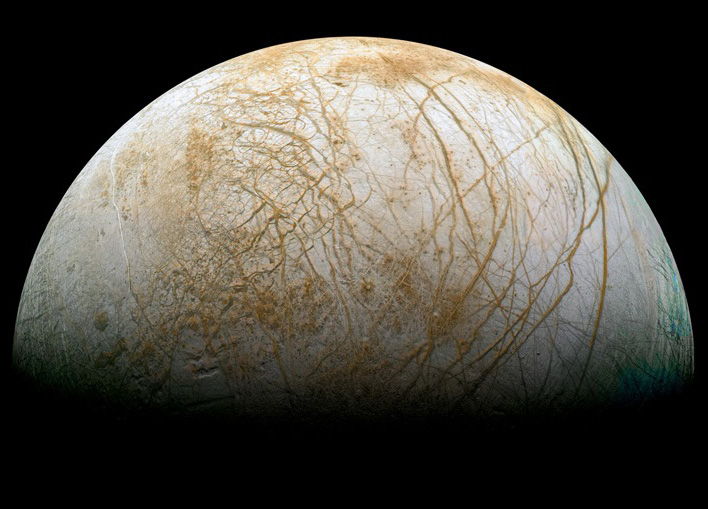Jupiter's Icy Moon Europa: Best Bet for Alien Life?

WASHINGTON — Jupiter's moon Europa doesn't look like a particularly inviting place for life to thrive; the icy satellite is nearly 500 million miles (800 million kilometers) from the sun, on average.
But beneath its icy crust lies a liquid ocean with more water than Earth contains. This ocean is shielded from harmful radiation, making Europa one of the solar system's best bets to host alien life.
That's one of the reasons Europa is so alluring to scientists. It has all the elements thought to be key for the origin of life: water, energy, and organic chemicals, the carbon-containing building blocks of life, scientists said at an event called "The Lure of Europa," held here last month. [Europa and Its Underground Ocean (Video)]
"All the ingredients are there to make us think Europa is the next place to go," NASA Chief Scientist Ellen Stofan said at the event, which was organized by the Planetary Society, a nonprofit organization headed by scientist and TV host Bill Nye.
Looking for life
Just as a layer of ice over a pond allows the water beneath it to stay liquid through the freezing winter, Europa's icy crust shields its enormous ocean despite the moon's great distance from the sun. As Europa travels around Jupiter, the massive planet bends and flexes the satellite, generating interior heat that keeps its water from freezing completely.
Beneath Europa's surface, active volcanoes may also heat the water, providing vents where bacterial life may thrive as it does on Earth.
"With that combination of volcanism and water, good things are going to happen," Stofan said.
Get the Space.com Newsletter
Breaking space news, the latest updates on rocket launches, skywatching events and more!

Further, it may be possible for a probe to get through Europa's crust, and into the ocean below. A space mission should be able to get through ice a few kilometers thick, Robert Pappalardo, of NASA's Jet Propulsion Laboratory in Pasadena, California, told Space.com after the event. Europa's variable ice shell may be that thin in places.
In addition to Europa's ocean, a second potential site for life exists in the moon's subsurface lakes. Some bubbles of energy from beneath the surface don't make it all the way through the crust but instead melt some of its ice. The lakes that form from the meltwater last hundreds of thousands — or perhaps millions — of years, and scientists estimate that some of these lakes contain more water than all of North America's Great Lakes. [6 Most Likely Places for Alien Life in the Solar System]
At the end of last year, NASA's Hubble Space Telescope discovered a third region where scientists could search for the ingredients for life: geysers of water vapor erupting from Europa's southern hemisphere, possibly allowing a flyby probe to sample the moon's subsurface sea from afar.
"The seawater is spewing into space," Nye said.
He urged scientists to fly by and "look at what's collecting on the windshield."
An upcoming mission

Every 10 years, the U.S. National Research Council issues a Planetary Science Decadal Review. The 2011 report ranked the exploration of Europa as one of the highest-priority missions. But budget cuts to NASA's Planetary Science program and a focus on the inner solar system have so far kept any mission concept from coming to fruition.
However, NASA's 2015 budget request includes funding to help plan a potential Europa mission. The same week as the Planetary Society's conference, the agency asked researchers to propose scientific instruments for a mission to the icy moon.
According to John Grunsfeld, associate administrator for NASA's Science Mission Directorate, a flyby spacecraft would most likely be easier to implement than a Europa orbiter. Grunsfeld was not part of the panel but was in the audience, and he answered several questions after the session.
Another mission option could include a vehicle that would transport a number of tiny "CubeSats" (mini satellite payloads) to the moon and deposit them on the surface to do a variety of experiments, Grunsfeld said.
Nye emphasized that getting to Europa requires long-term planning — not only for the mission itself, but also for the voyage to the outer solar system.
"There is a lot of space in space," he said, pointing out that it would take a number of years for any probe to get to Europa.
Funding the voyage
The cost of doing planetary science at Europa is less than $2 billion — a small amount when compared to many government expenditures, Nye noted. He compared it to the cost of each taxpayer purchasing a single cup of coffee.
"If we found evidence for life on another world, you would be part of it," he said.
In general, robotic missions have a relatively low cost and a high return in planetary science, Nye said.
Spinoff science and technology resulting from the study of Europa would also be a benefit, he added. Space exploration has already brought a number of technological advances. In addition to the amazement and wonder that would come with the discovery of life elsewhere in the solar system, finding a new ecosystem would likely have a profound effect on medical science, Nye said.
Exploring Europa doesn't mean that life would be discovered immediately. In fact, in a discussion after the conference, Stofan said that pinning down the discovery of life unambiguously would probably not be possible with only a fly-through of Europa's plumes. What could be definitively measured, however, is whether the water vapor spewing from the planet contains amino acids, the building blocks of life.
But the first step is to find out if Europa is the kind of place that would support life, Pappalardo said. "Finding out if it does is a tougher thing to do," he said.
Figuring out whether Europa harbors life would probably require returning samples from the plumes or elsewhere on the moon to be studied on Earth, where they could be studied in depth. But humans have not yet managed to return samples from Mars, which is much closer than Europa, so accomplishing this for Europa may not happen until the more distant future.
Stofan said she didn't think human exploration on the surface of Europa is likely, given the high radiation levels there. Robotic studies of the icy moon, such as the proposed Europa Clipper mission, would be the primary method of study.
"We are the first generation of humans who could send a mission to these extraordinary places — Mars and Europa — to search for life," Nye said.
Follow us @Spacedotcom, Facebook or Google+. Originally published on Space.com.
Join our Space Forums to keep talking space on the latest missions, night sky and more! And if you have a news tip, correction or comment, let us know at: community@space.com.

Nola Taylor Tillman is a contributing writer for Space.com. She loves all things space and astronomy-related, and enjoys the opportunity to learn more. She has a Bachelor’s degree in English and Astrophysics from Agnes Scott college and served as an intern at Sky & Telescope magazine. In her free time, she homeschools her four children. Follow her on Twitter at @NolaTRedd










